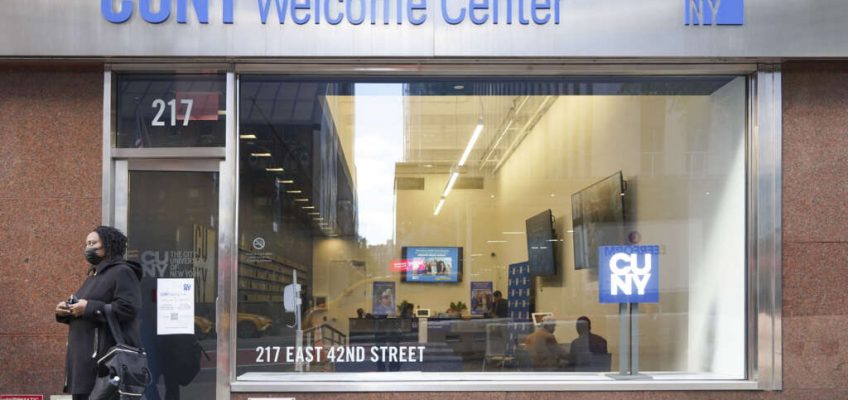“At a time when the federal government is targeting the communities of color and immigrant communities that CUNY serves, New Yorkers need a mayor who will be a champion for CUNY.”
(NYC Council Media Unit)
In January 2017, then-Gov. Andrew Cuomo stood with Bernie Sanders at CUNY’s LaGuardia Community College to announce his plan for free tuition at New York’s public colleges, under banners that read “Excelsior Scholarship.” His budget director wrote that 900,000 families would qualify for the new program. As a CUNY student and campus organizer at the time, I was excited to think that my classmates would no longer struggle to afford college.
Then, in the fall of 2017, CUNY tuition increased by $200. It was the seventh consecutive tuition hike at CUNY since Cuomo was elected.
Students learned the hard way that Cuomo misled New Yorkers about the Excelsior Scholarship. Despite the subway ads claiming “Free College for All,” only 5 percent of CUNY students actually received Excelsior, including a lackluster 0.4 percent of community college students, barely helping the students who needed it the most. Its “Super full-time” credit requirement made Excelsior nearly impossible for most students to qualify, with half of all CUNY students working to support themselves and their families while pursuing their studies.
CUNY students need free tuition. Half of undergraduates come from households with less than $30,000 in annual income, while 60 percent are first generation college students, and more than a third were born overseas. But instead of supporting a stronger future for these New Yorkers, Cuomo systemically underfunded CUNY, starving its 240,000 students at 26 colleges of resources and opportunities.
In 2011, Cuomo convinced Albany to enact NYSUNY2020, legislation that established annual tuition hikes and capped Tuition Assistance Program (TAP) payments to colleges. Between 2011 and 2020, students at CUNY and SUNY students paid at least $2.5 billion in additional tuition.
University leaders hoped the hikes would come with increases in state operating funding. Instead, Cuomo kept CUNY’s operating funding essentially flat as costs rose and ignored the growing “TAP Gap” of missing state revenue. He refused to fund collectively bargained wage increases for the faculty and staff (or any state workers), forcing CUNY to cut student services at senior colleges across the city. Three times he vetoed Maintenance of Effort legislation that would have stabilized funding for CUNY.
In 2016, Cuomo proposed a $485 million cut to CUNY’s state funding as part of a scheme to shift costs onto New York City. CUNY’s chancellor at the time testified in Albany that “numerous colleges…would have to be closed.” Thankfully, New Yorkers and elected officials rallied against the plan, and the governor backed off.
Later, Cuomo’s decision to withhold and then cut millions from CUNY’s budget at the outset of the pandemic led to the layoff of more than 2,000 adjunct faculty.
Cuomo’s disinvestment had real consequences: students like me had to work more hours to afford tuition, with some of my classmates dropping out in response to rising costs. A third of CUNY students under Cuomo had difficulty registering for courses, impeding our progress toward degrees.
CUNY’s full-time faculty shortage worsened as administrators hired part-time, poverty-wage adjunct faculty with no job security, who now teach most courses. And staffing shortages led to long lines and overwhelmed student services. While tuition hikes made it more expensive to attend college, I became a more frequent visitor of food pantries. Not long before COVID, a study showed I was not alone: 48 percent of CUNY students had experienced food insecurity in the past month, while 55 percent had been housing insecure in the past year.
At a time when the federal government is targeting the communities of color and immigrant communities that CUNY serves, New Yorkers need a mayor who will be a champion for CUNY. We have here a diamond in the rough. CUNYs regularly top the lists of “Best Value” colleges. In the Wall Street Journal’s latest ranking, they filled the top seven positions. One study found that every dollar invested in City College of New York generates a return of $9.30 in benefits.
My experience as a student, and Cuomo’s record of austerity funding for CUNY, show that electing Cuomo mayor would be a bad deal for CUNY students and their families.
In contrast, Zohran Mamdani is a cosponsor in the Assembly of the New Deal for CUNY, legislation to make CUNY tuition-free and fully funded. Mamdani also sponsors the REPAIR Acts, bills that would end property tax exemptions for NYU and Columbia and redirect $300 million of that funding to CUNY. He is a fighter for public education, and would bring the bold, ambitious leadership that CUNY needs to thrive.
Enrique Peña-Oropeza is a community advocate for public education, and a two-time CUNY grad pursuing another degree at CUNY School of Law.
The post Opinion: Why Cuomo Would Be a Bad Deal for CUNY appeared first on City Limits.


Leave a Reply